Comprehensive Balanced Scorecard Analysis Report: Business Strategies
VerifiedAdded on 2021/06/16
|6
|1491
|17
Report
AI Summary
This report presents a balanced scorecard (BSC) analysis, focusing on various perspectives to assess business performance. The report includes an analysis of financial, customer, internal business process, and learning and growth aspects. It examines the objectives, strategies, and performance measures for each perspective, including financial returns, customer satisfaction, internal process improvements, and employee development. The analysis also highlights the need to incorporate a fifth perspective, sustainability, to evaluate the non-market impacts of the business. The report provides a comprehensive overview of the company's performance across different dimensions and suggests improvements for strategic planning and sustainable operations. References are provided to support the analysis.
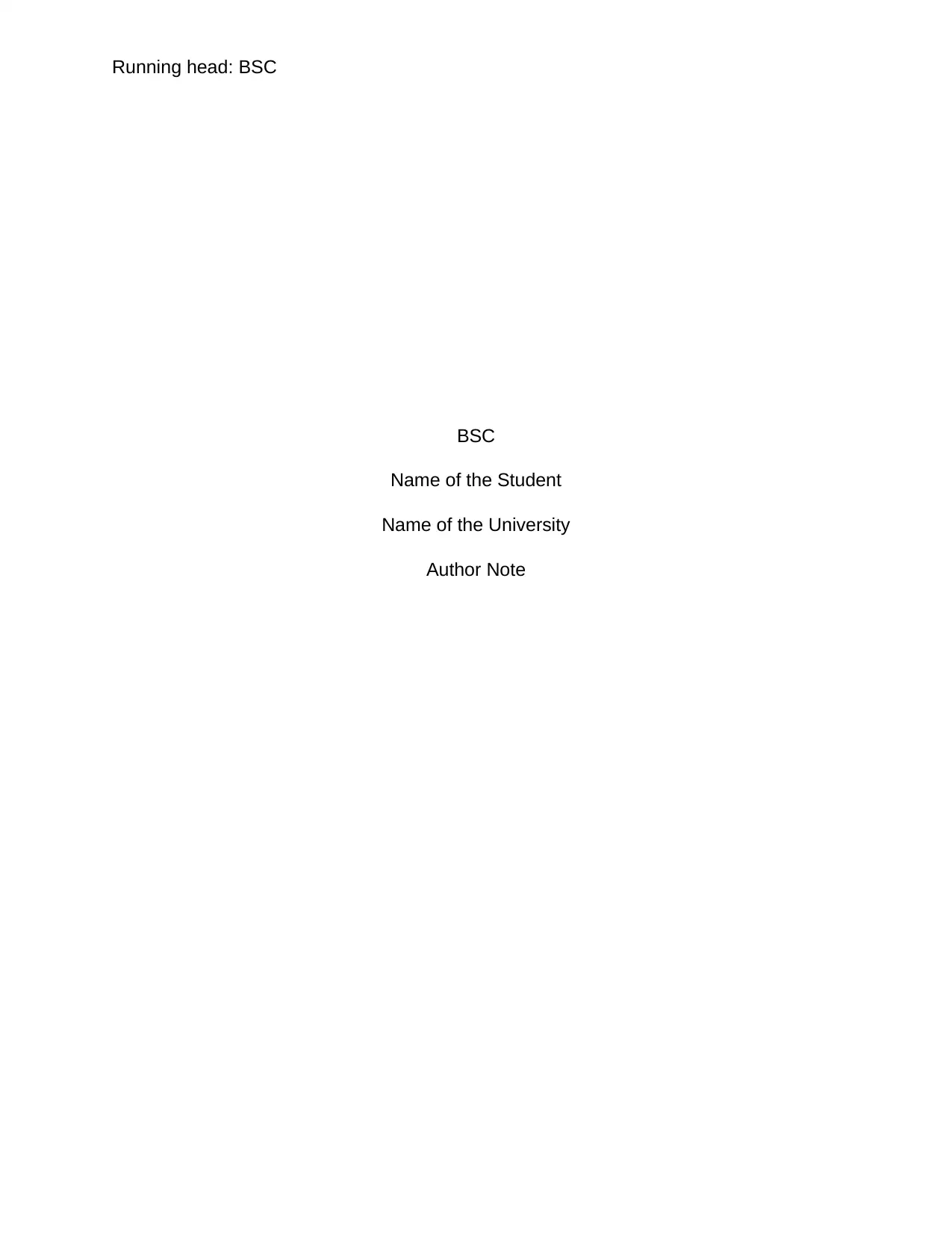
Running head: BSC
BSC
Name of the Student
Name of the University
Author Note
BSC
Name of the Student
Name of the University
Author Note
Paraphrase This Document
Need a fresh take? Get an instant paraphrase of this document with our AI Paraphraser
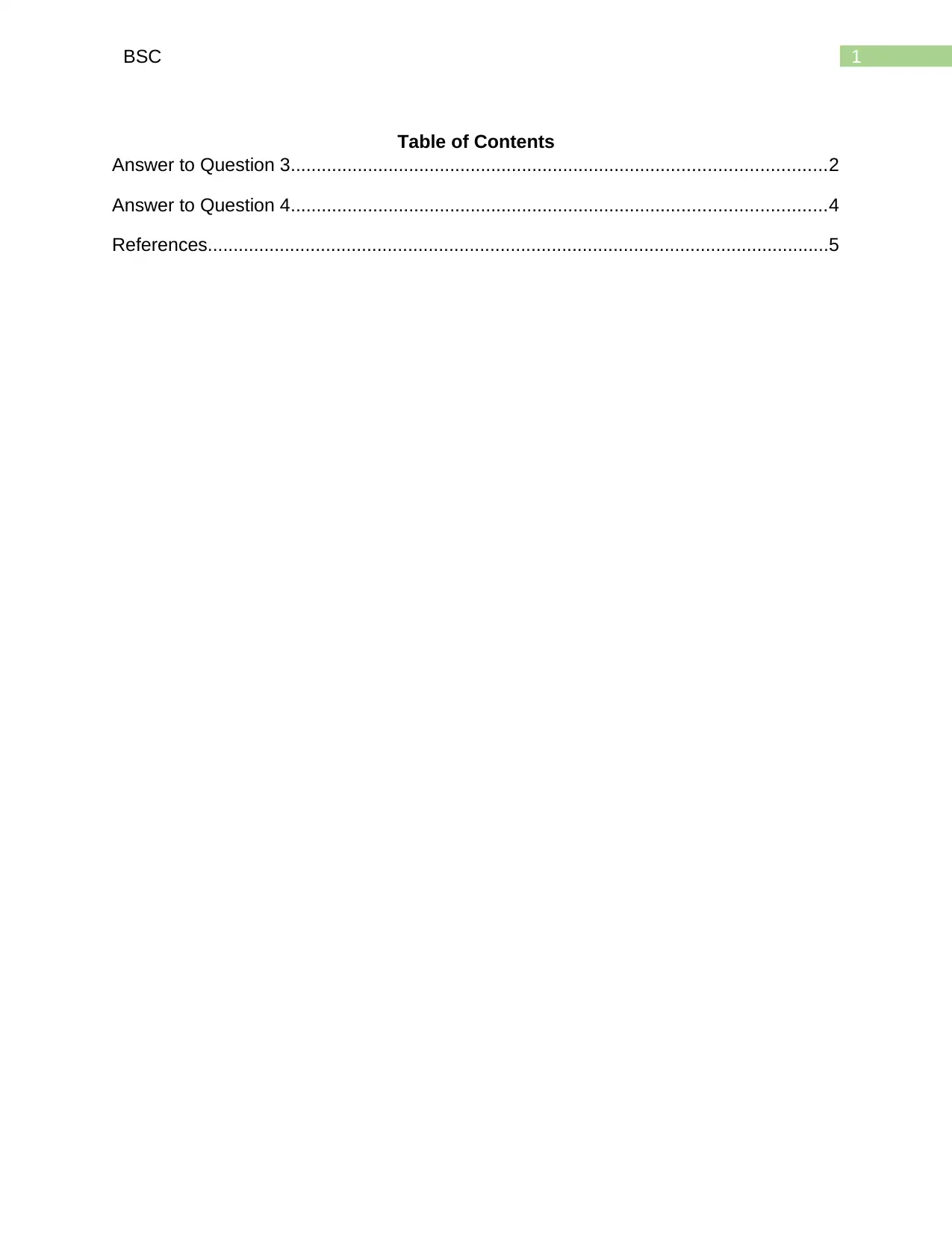
1BSC
Table of Contents
Answer to Question 3........................................................................................................2
Answer to Question 4........................................................................................................4
References.........................................................................................................................5
Table of Contents
Answer to Question 3........................................................................................................2
Answer to Question 4........................................................................................................4
References.........................................................................................................................5
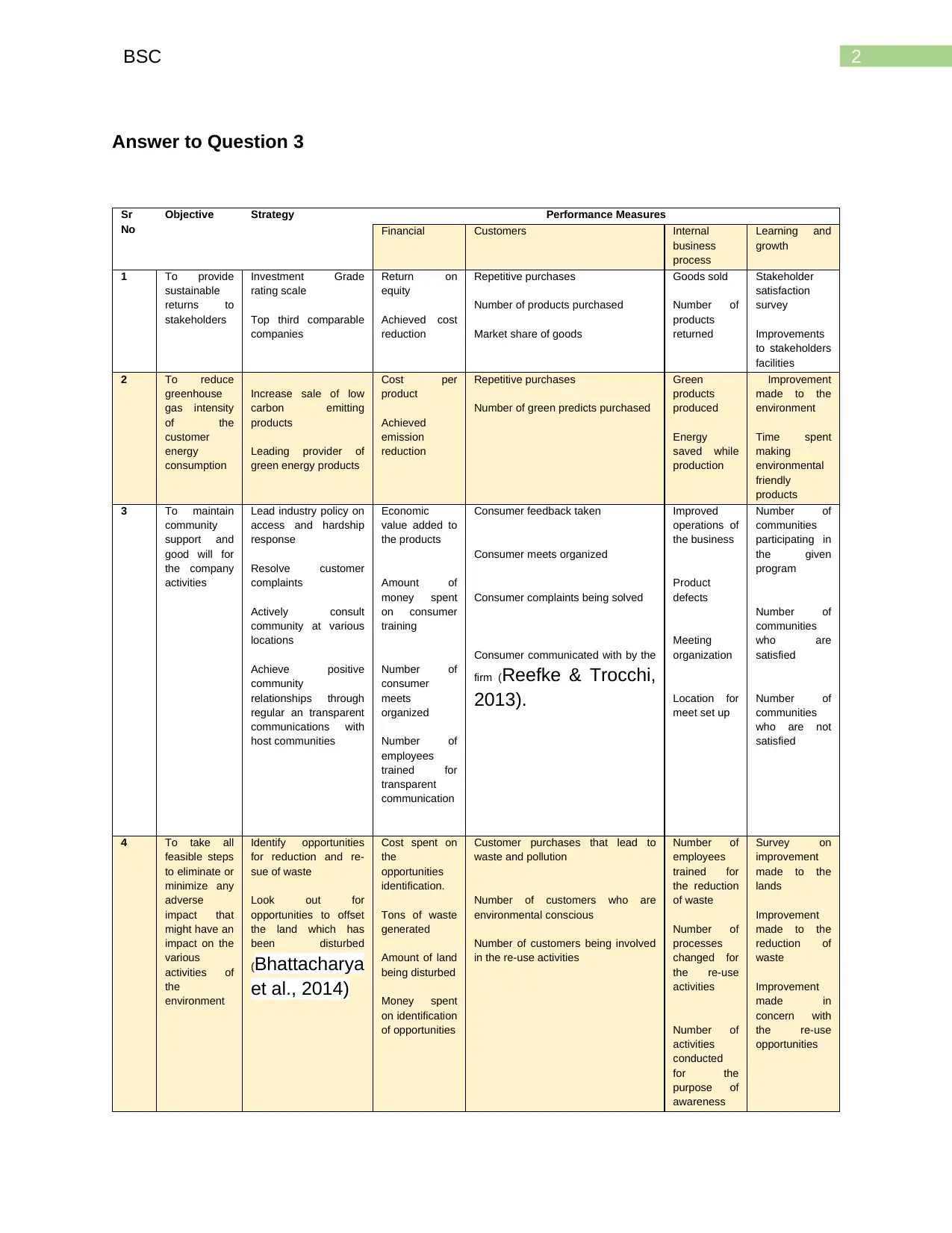
2BSC
Answer to Question 3
Sr
No
Objective Strategy Performance Measures
Financial Customers Internal
business
process
Learning and
growth
1 To provide
sustainable
returns to
stakeholders
Investment Grade
rating scale
Top third comparable
companies
Return on
equity
Achieved cost
reduction
Repetitive purchases
Number of products purchased
Market share of goods
Goods sold
Number of
products
returned
Stakeholder
satisfaction
survey
Improvements
to stakeholders
facilities
2 To reduce
greenhouse
gas intensity
of the
customer
energy
consumption
Increase sale of low
carbon emitting
products
Leading provider of
green energy products
Cost per
product
Achieved
emission
reduction
Repetitive purchases
Number of green predicts purchased
Green
products
produced
Energy
saved while
production
Improvement
made to the
environment
Time spent
making
environmental
friendly
products
3 To maintain
community
support and
good will for
the company
activities
Lead industry policy on
access and hardship
response
Resolve customer
complaints
Actively consult
community at various
locations
Achieve positive
community
relationships through
regular an transparent
communications with
host communities
Economic
value added to
the products
Amount of
money spent
on consumer
training
Number of
consumer
meets
organized
Number of
employees
trained for
transparent
communication
Consumer feedback taken
Consumer meets organized
Consumer complaints being solved
Consumer communicated with by the
firm (Reefke & Trocchi,
2013).
Improved
operations of
the business
Product
defects
Meeting
organization
Location for
meet set up
Number of
communities
participating in
the given
program
Number of
communities
who are
satisfied
Number of
communities
who are not
satisfied
4 To take all
feasible steps
to eliminate or
minimize any
adverse
impact that
might have an
impact on the
various
activities of
the
environment
Identify opportunities
for reduction and re-
sue of waste
Look out for
opportunities to offset
the land which has
been disturbed
(Bhattacharya
et al., 2014)
Cost spent on
the
opportunities
identification.
Tons of waste
generated
Amount of land
being disturbed
Money spent
on identification
of opportunities
Customer purchases that lead to
waste and pollution
Number of customers who are
environmental conscious
Number of customers being involved
in the re-use activities
Number of
employees
trained for
the reduction
of waste
Number of
processes
changed for
the re-use
activities
Number of
activities
conducted
for the
purpose of
awareness
Survey on
improvement
made to the
lands
Improvement
made to the
reduction of
waste
Improvement
made in
concern with
the re-use
opportunities
Answer to Question 3
Sr
No
Objective Strategy Performance Measures
Financial Customers Internal
business
process
Learning and
growth
1 To provide
sustainable
returns to
stakeholders
Investment Grade
rating scale
Top third comparable
companies
Return on
equity
Achieved cost
reduction
Repetitive purchases
Number of products purchased
Market share of goods
Goods sold
Number of
products
returned
Stakeholder
satisfaction
survey
Improvements
to stakeholders
facilities
2 To reduce
greenhouse
gas intensity
of the
customer
energy
consumption
Increase sale of low
carbon emitting
products
Leading provider of
green energy products
Cost per
product
Achieved
emission
reduction
Repetitive purchases
Number of green predicts purchased
Green
products
produced
Energy
saved while
production
Improvement
made to the
environment
Time spent
making
environmental
friendly
products
3 To maintain
community
support and
good will for
the company
activities
Lead industry policy on
access and hardship
response
Resolve customer
complaints
Actively consult
community at various
locations
Achieve positive
community
relationships through
regular an transparent
communications with
host communities
Economic
value added to
the products
Amount of
money spent
on consumer
training
Number of
consumer
meets
organized
Number of
employees
trained for
transparent
communication
Consumer feedback taken
Consumer meets organized
Consumer complaints being solved
Consumer communicated with by the
firm (Reefke & Trocchi,
2013).
Improved
operations of
the business
Product
defects
Meeting
organization
Location for
meet set up
Number of
communities
participating in
the given
program
Number of
communities
who are
satisfied
Number of
communities
who are not
satisfied
4 To take all
feasible steps
to eliminate or
minimize any
adverse
impact that
might have an
impact on the
various
activities of
the
environment
Identify opportunities
for reduction and re-
sue of waste
Look out for
opportunities to offset
the land which has
been disturbed
(Bhattacharya
et al., 2014)
Cost spent on
the
opportunities
identification.
Tons of waste
generated
Amount of land
being disturbed
Money spent
on identification
of opportunities
Customer purchases that lead to
waste and pollution
Number of customers who are
environmental conscious
Number of customers being involved
in the re-use activities
Number of
employees
trained for
the reduction
of waste
Number of
processes
changed for
the re-use
activities
Number of
activities
conducted
for the
purpose of
awareness
Survey on
improvement
made to the
lands
Improvement
made to the
reduction of
waste
Improvement
made in
concern with
the re-use
opportunities
⊘ This is a preview!⊘
Do you want full access?
Subscribe today to unlock all pages.

Trusted by 1+ million students worldwide
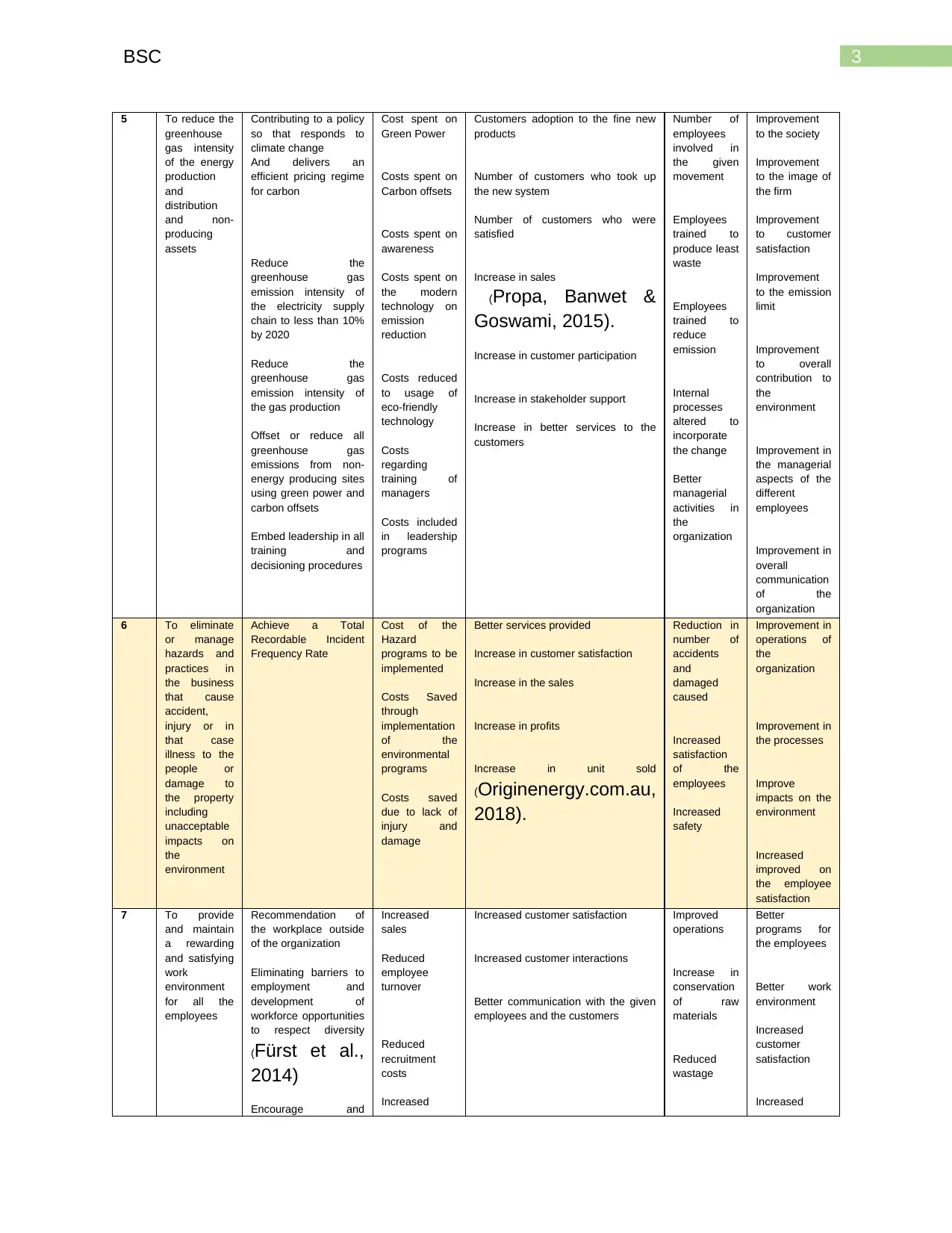
3BSC
5 To reduce the
greenhouse
gas intensity
of the energy
production
and
distribution
and non-
producing
assets
Contributing to a policy
so that responds to
climate change
And delivers an
efficient pricing regime
for carbon
Reduce the
greenhouse gas
emission intensity of
the electricity supply
chain to less than 10%
by 2020
Reduce the
greenhouse gas
emission intensity of
the gas production
Offset or reduce all
greenhouse gas
emissions from non-
energy producing sites
using green power and
carbon offsets
Embed leadership in all
training and
decisioning procedures
Cost spent on
Green Power
Costs spent on
Carbon offsets
Costs spent on
awareness
Costs spent on
the modern
technology on
emission
reduction
Costs reduced
to usage of
eco-friendly
technology
Costs
regarding
training of
managers
Costs included
in leadership
programs
Customers adoption to the fine new
products
Number of customers who took up
the new system
Number of customers who were
satisfied
Increase in sales
(Propa, Banwet &
Goswami, 2015).
Increase in customer participation
Increase in stakeholder support
Increase in better services to the
customers
Number of
employees
involved in
the given
movement
Employees
trained to
produce least
waste
Employees
trained to
reduce
emission
Internal
processes
altered to
incorporate
the change
Better
managerial
activities in
the
organization
Improvement
to the society
Improvement
to the image of
the firm
Improvement
to customer
satisfaction
Improvement
to the emission
limit
Improvement
to overall
contribution to
the
environment
Improvement in
the managerial
aspects of the
different
employees
Improvement in
overall
communication
of the
organization
6 To eliminate
or manage
hazards and
practices in
the business
that cause
accident,
injury or in
that case
illness to the
people or
damage to
the property
including
unacceptable
impacts on
the
environment
Achieve a Total
Recordable Incident
Frequency Rate
Cost of the
Hazard
programs to be
implemented
Costs Saved
through
implementation
of the
environmental
programs
Costs saved
due to lack of
injury and
damage
Better services provided
Increase in customer satisfaction
Increase in the sales
Increase in profits
Increase in unit sold
(Originenergy.com.au,
2018).
Reduction in
number of
accidents
and
damaged
caused
Increased
satisfaction
of the
employees
Increased
safety
Improvement in
operations of
the
organization
Improvement in
the processes
Improve
impacts on the
environment
Increased
improved on
the employee
satisfaction
7 To provide
and maintain
a rewarding
and satisfying
work
environment
for all the
employees
Recommendation of
the workplace outside
of the organization
Eliminating barriers to
employment and
development of
workforce opportunities
to respect diversity
(Fürst et al.,
2014)
Encourage and
Increased
sales
Reduced
employee
turnover
Reduced
recruitment
costs
Increased
Increased customer satisfaction
Increased customer interactions
Better communication with the given
employees and the customers
Improved
operations
Increase in
conservation
of raw
materials
Reduced
wastage
Better
programs for
the employees
Better work
environment
Increased
customer
satisfaction
Increased
5 To reduce the
greenhouse
gas intensity
of the energy
production
and
distribution
and non-
producing
assets
Contributing to a policy
so that responds to
climate change
And delivers an
efficient pricing regime
for carbon
Reduce the
greenhouse gas
emission intensity of
the electricity supply
chain to less than 10%
by 2020
Reduce the
greenhouse gas
emission intensity of
the gas production
Offset or reduce all
greenhouse gas
emissions from non-
energy producing sites
using green power and
carbon offsets
Embed leadership in all
training and
decisioning procedures
Cost spent on
Green Power
Costs spent on
Carbon offsets
Costs spent on
awareness
Costs spent on
the modern
technology on
emission
reduction
Costs reduced
to usage of
eco-friendly
technology
Costs
regarding
training of
managers
Costs included
in leadership
programs
Customers adoption to the fine new
products
Number of customers who took up
the new system
Number of customers who were
satisfied
Increase in sales
(Propa, Banwet &
Goswami, 2015).
Increase in customer participation
Increase in stakeholder support
Increase in better services to the
customers
Number of
employees
involved in
the given
movement
Employees
trained to
produce least
waste
Employees
trained to
reduce
emission
Internal
processes
altered to
incorporate
the change
Better
managerial
activities in
the
organization
Improvement
to the society
Improvement
to the image of
the firm
Improvement
to customer
satisfaction
Improvement
to the emission
limit
Improvement
to overall
contribution to
the
environment
Improvement in
the managerial
aspects of the
different
employees
Improvement in
overall
communication
of the
organization
6 To eliminate
or manage
hazards and
practices in
the business
that cause
accident,
injury or in
that case
illness to the
people or
damage to
the property
including
unacceptable
impacts on
the
environment
Achieve a Total
Recordable Incident
Frequency Rate
Cost of the
Hazard
programs to be
implemented
Costs Saved
through
implementation
of the
environmental
programs
Costs saved
due to lack of
injury and
damage
Better services provided
Increase in customer satisfaction
Increase in the sales
Increase in profits
Increase in unit sold
(Originenergy.com.au,
2018).
Reduction in
number of
accidents
and
damaged
caused
Increased
satisfaction
of the
employees
Increased
safety
Improvement in
operations of
the
organization
Improvement in
the processes
Improve
impacts on the
environment
Increased
improved on
the employee
satisfaction
7 To provide
and maintain
a rewarding
and satisfying
work
environment
for all the
employees
Recommendation of
the workplace outside
of the organization
Eliminating barriers to
employment and
development of
workforce opportunities
to respect diversity
(Fürst et al.,
2014)
Encourage and
Increased
sales
Reduced
employee
turnover
Reduced
recruitment
costs
Increased
Increased customer satisfaction
Increased customer interactions
Better communication with the given
employees and the customers
Improved
operations
Increase in
conservation
of raw
materials
Reduced
wastage
Better
programs for
the employees
Better work
environment
Increased
customer
satisfaction
Increased
Paraphrase This Document
Need a fresh take? Get an instant paraphrase of this document with our AI Paraphraser
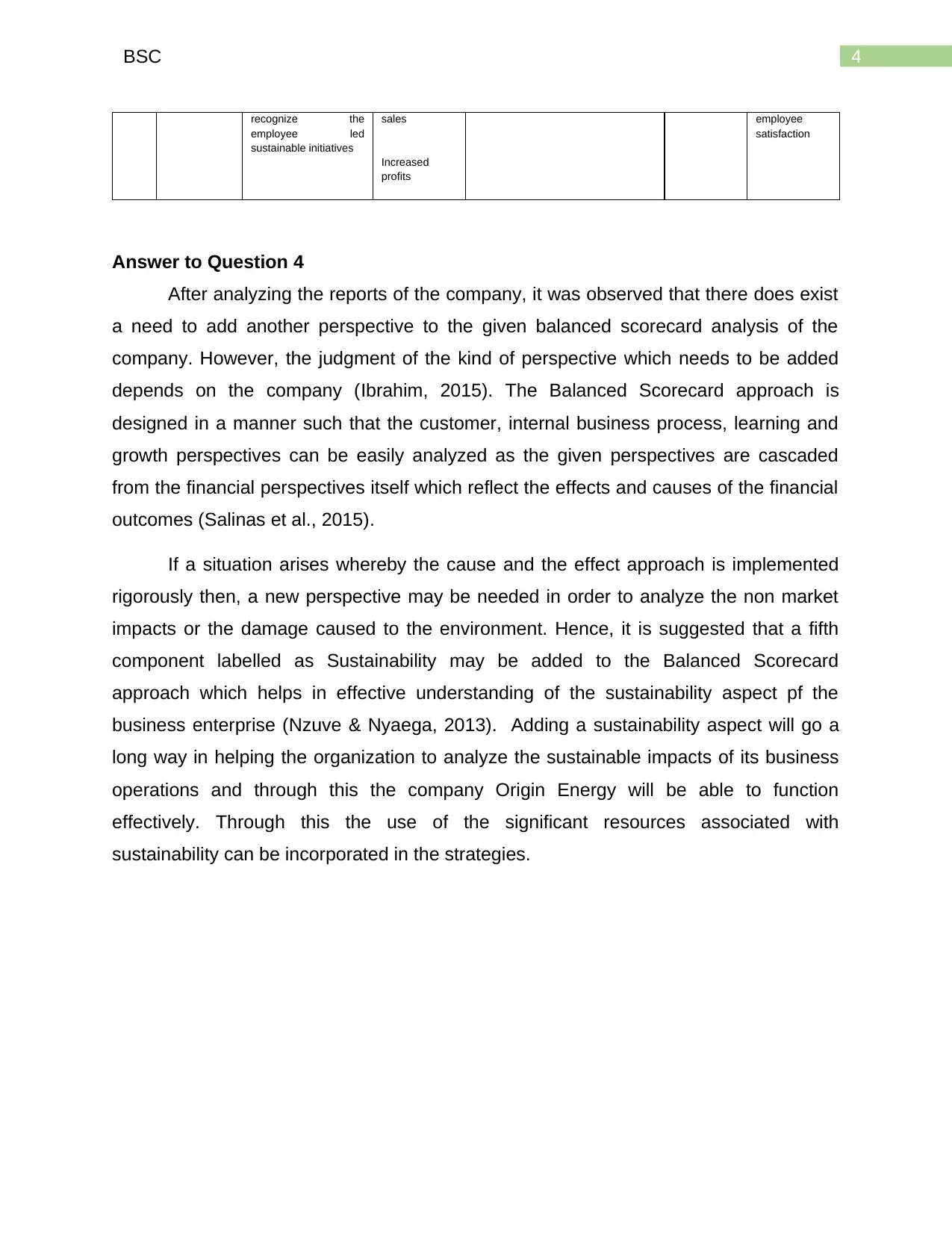
4BSC
recognize the
employee led
sustainable initiatives
sales
Increased
profits
employee
satisfaction
Answer to Question 4
After analyzing the reports of the company, it was observed that there does exist
a need to add another perspective to the given balanced scorecard analysis of the
company. However, the judgment of the kind of perspective which needs to be added
depends on the company (Ibrahim, 2015). The Balanced Scorecard approach is
designed in a manner such that the customer, internal business process, learning and
growth perspectives can be easily analyzed as the given perspectives are cascaded
from the financial perspectives itself which reflect the effects and causes of the financial
outcomes (Salinas et al., 2015).
If a situation arises whereby the cause and the effect approach is implemented
rigorously then, a new perspective may be needed in order to analyze the non market
impacts or the damage caused to the environment. Hence, it is suggested that a fifth
component labelled as Sustainability may be added to the Balanced Scorecard
approach which helps in effective understanding of the sustainability aspect pf the
business enterprise (Nzuve & Nyaega, 2013). Adding a sustainability aspect will go a
long way in helping the organization to analyze the sustainable impacts of its business
operations and through this the company Origin Energy will be able to function
effectively. Through this the use of the significant resources associated with
sustainability can be incorporated in the strategies.
recognize the
employee led
sustainable initiatives
sales
Increased
profits
employee
satisfaction
Answer to Question 4
After analyzing the reports of the company, it was observed that there does exist
a need to add another perspective to the given balanced scorecard analysis of the
company. However, the judgment of the kind of perspective which needs to be added
depends on the company (Ibrahim, 2015). The Balanced Scorecard approach is
designed in a manner such that the customer, internal business process, learning and
growth perspectives can be easily analyzed as the given perspectives are cascaded
from the financial perspectives itself which reflect the effects and causes of the financial
outcomes (Salinas et al., 2015).
If a situation arises whereby the cause and the effect approach is implemented
rigorously then, a new perspective may be needed in order to analyze the non market
impacts or the damage caused to the environment. Hence, it is suggested that a fifth
component labelled as Sustainability may be added to the Balanced Scorecard
approach which helps in effective understanding of the sustainability aspect pf the
business enterprise (Nzuve & Nyaega, 2013). Adding a sustainability aspect will go a
long way in helping the organization to analyze the sustainable impacts of its business
operations and through this the company Origin Energy will be able to function
effectively. Through this the use of the significant resources associated with
sustainability can be incorporated in the strategies.
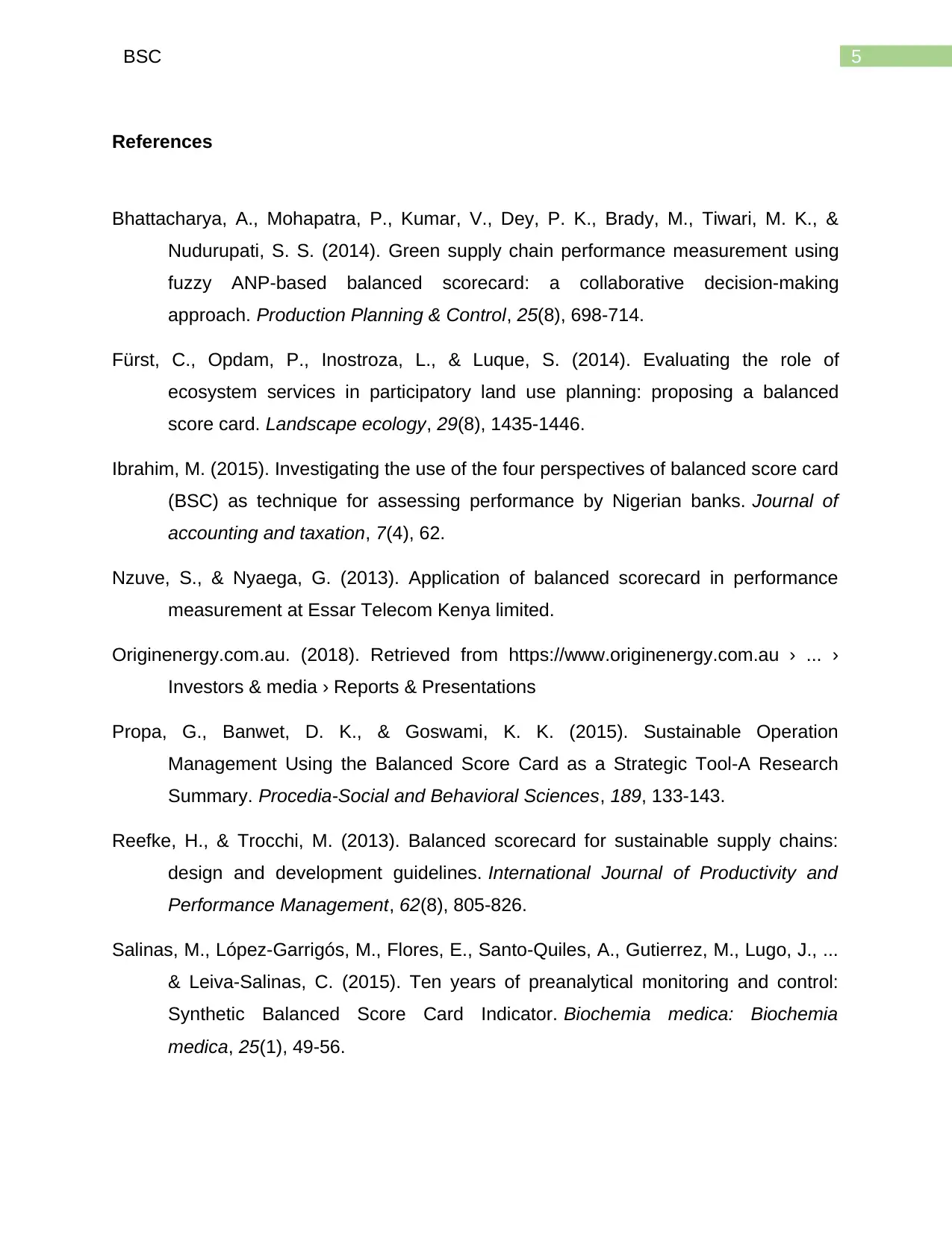
5BSC
References
Bhattacharya, A., Mohapatra, P., Kumar, V., Dey, P. K., Brady, M., Tiwari, M. K., &
Nudurupati, S. S. (2014). Green supply chain performance measurement using
fuzzy ANP-based balanced scorecard: a collaborative decision-making
approach. Production Planning & Control, 25(8), 698-714.
Fürst, C., Opdam, P., Inostroza, L., & Luque, S. (2014). Evaluating the role of
ecosystem services in participatory land use planning: proposing a balanced
score card. Landscape ecology, 29(8), 1435-1446.
Ibrahim, M. (2015). Investigating the use of the four perspectives of balanced score card
(BSC) as technique for assessing performance by Nigerian banks. Journal of
accounting and taxation, 7(4), 62.
Nzuve, S., & Nyaega, G. (2013). Application of balanced scorecard in performance
measurement at Essar Telecom Kenya limited.
Originenergy.com.au. (2018). Retrieved from https://www.originenergy.com.au › ... ›
Investors & media › Reports & Presentations
Propa, G., Banwet, D. K., & Goswami, K. K. (2015). Sustainable Operation
Management Using the Balanced Score Card as a Strategic Tool-A Research
Summary. Procedia-Social and Behavioral Sciences, 189, 133-143.
Reefke, H., & Trocchi, M. (2013). Balanced scorecard for sustainable supply chains:
design and development guidelines. International Journal of Productivity and
Performance Management, 62(8), 805-826.
Salinas, M., López-Garrigós, M., Flores, E., Santo-Quiles, A., Gutierrez, M., Lugo, J., ...
& Leiva-Salinas, C. (2015). Ten years of preanalytical monitoring and control:
Synthetic Balanced Score Card Indicator. Biochemia medica: Biochemia
medica, 25(1), 49-56.
References
Bhattacharya, A., Mohapatra, P., Kumar, V., Dey, P. K., Brady, M., Tiwari, M. K., &
Nudurupati, S. S. (2014). Green supply chain performance measurement using
fuzzy ANP-based balanced scorecard: a collaborative decision-making
approach. Production Planning & Control, 25(8), 698-714.
Fürst, C., Opdam, P., Inostroza, L., & Luque, S. (2014). Evaluating the role of
ecosystem services in participatory land use planning: proposing a balanced
score card. Landscape ecology, 29(8), 1435-1446.
Ibrahim, M. (2015). Investigating the use of the four perspectives of balanced score card
(BSC) as technique for assessing performance by Nigerian banks. Journal of
accounting and taxation, 7(4), 62.
Nzuve, S., & Nyaega, G. (2013). Application of balanced scorecard in performance
measurement at Essar Telecom Kenya limited.
Originenergy.com.au. (2018). Retrieved from https://www.originenergy.com.au › ... ›
Investors & media › Reports & Presentations
Propa, G., Banwet, D. K., & Goswami, K. K. (2015). Sustainable Operation
Management Using the Balanced Score Card as a Strategic Tool-A Research
Summary. Procedia-Social and Behavioral Sciences, 189, 133-143.
Reefke, H., & Trocchi, M. (2013). Balanced scorecard for sustainable supply chains:
design and development guidelines. International Journal of Productivity and
Performance Management, 62(8), 805-826.
Salinas, M., López-Garrigós, M., Flores, E., Santo-Quiles, A., Gutierrez, M., Lugo, J., ...
& Leiva-Salinas, C. (2015). Ten years of preanalytical monitoring and control:
Synthetic Balanced Score Card Indicator. Biochemia medica: Biochemia
medica, 25(1), 49-56.
⊘ This is a preview!⊘
Do you want full access?
Subscribe today to unlock all pages.

Trusted by 1+ million students worldwide
1 out of 6
Related Documents
Your All-in-One AI-Powered Toolkit for Academic Success.
+13062052269
info@desklib.com
Available 24*7 on WhatsApp / Email
![[object Object]](/_next/static/media/star-bottom.7253800d.svg)
Unlock your academic potential
Copyright © 2020–2025 A2Z Services. All Rights Reserved. Developed and managed by ZUCOL.





